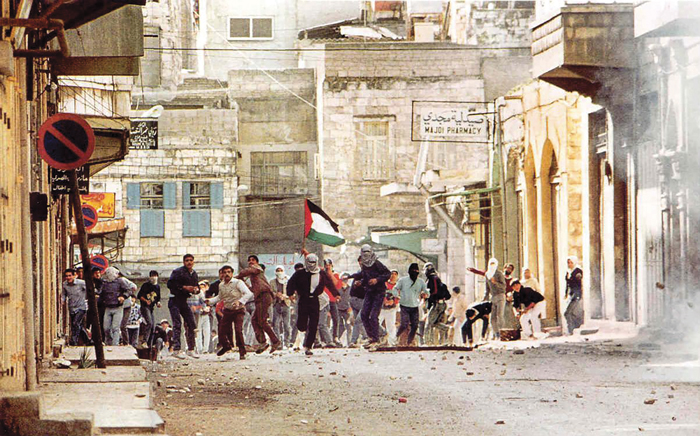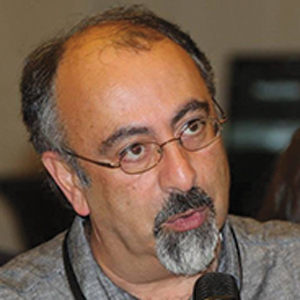
The common history of the Palestinian struggle against the occupation, to the extent that there is one, takes the diaspora as its starting point, with the rise of the fedayeen movements in the 1960s. Little attention was ever given to the emergence and development of the movement inside the occupied territory, except as an extension of the leadership outside. This short essay is a preliminary attempt to fill in the gap by granting Palestinians “inside” a certain agency that they have previously been denied in the general discourse. Based solely on my recollection of events that I witnessed and have reflected upon, this article makes no claim to be comprehensive or founded on archival or documentary research.
Following the occupation of what was left of Palestine in 1967, a resistance movement immediately emerged. However, the core of the movement was based outside the newly occupied territory, particularly in the refugee camps in Jordan, Lebanon, and Syria, where a number of paramilitary organizations already existed.
The Gaza Strip, which was governed by Egypt, had a number of active Palestinian movements with Palestinian forces known as the Palestine Liberation Army (PLA), under the auspices of the Egyptian army, actively recruiting young Palestinians. The PLA was the military branch of the newly established (in 1964) Palestine Liberation Organization (PLO). At the same time, the organization known as the Arab Nationalist Movement (ANM) was present and encouraged by the regime of President Gamal Abdel Nasser, to recruit freely as its vision was not significantly different from that of the regime itself. In addition, a Palestinian Communist Party was also active in the Strip, although its work was largely underground at the time. In the immediate aftermath of the occupation, the existence of these groups made it easier to organize against the occupation. Shortly after the war, the ANM dissolved itself, and a Palestinian branch of the movement was established under the name of the Popular Front for the Liberation of Palestine (PFLP), and many of the members of the ANM joined the newly established PFLP.
♦ The history of the Palestinian struggle seems, to a large extent, to have marginalized the pre-Intifada contributions of the West Bank and Gaza. It is time to rethink that “official narrative” by bringing the two regions into the picture.
In the West Bank, on the other hand, no political parties were allowed to function, though a few had supporters and members who resorted to underground work. Unlike the Egyptian rule in Gaza, Jordan annexed the West Bank and extended citizenship to its residents. Jordanian law did not allow the freedom to organize within political organizations – perhaps with the exception of the Muslim Brotherhood Movement, whose activities were restricted to the realm of religious preaching. Underground organizations in Jordan and the West Bank at the time included the Ba’ath Party, the ANM, and the Jordanian Communist Party. Unlike in the Gaza Strip, military activities outside of the legitimate army of the state did not exist.
The difference in the conditions between the West Bank and the Gaza Strip during the period before the occupation had significant ramifications on the struggle in the two areas after the June 1967 war. Where the overcrowded Gaza Strip with the largest refugee population was more prepared for armed resistance, the subdued West Bank, with its strong connections to Jordan, was prepared for peaceful protests and acts of civil disobedience. Still, after a few years of armed struggle in Gaza, the Israeli authorities managed to crush the movement. Israel opened up its market to the Gazan labor force, a fact that tremendously helped the largely poor inhabitants of the Strip and, at the same time, helped Israeli to pacify the population.
The situation in the West Bank was different in some ways. Despite the imposition of an oppressive system of Israeli military rule that crushed any form of organization (be it civil or political) in the West Bank, Israel extended its civil law over occupied Jerusalem, a fact that gave Palestinians in the city the opportunity to organize and build national institutions, using the existing Israeli legal system that had a certain margin of freedoms otherwise denied in the rest of the territory. This is not to suggest that Palestinian activity in Jerusalem was unimpeded, but simply to recognize that the margin for organizing was a little easier in the city. By the early 1980s, Jerusalem had a number of active institutions and centers, such as the Arab Thought Forum and the Arab Studies Society, among others, whose main focus was the condition of the Palestinians under occupation. A number of Palestinian newspapers also appeared in Jerusalem during that period, including Al-Fajer, Al-Shaab, and Al-Tali’aa. Whereas the first two were connected with the PLO and largest faction, Fatah, the last one was the mouthpiece of the Palestinian communist organization – the autonomous West Bank branch of the Jordanian Communist Party at the time. Similarly, a few Jerusalem-based publishing houses emerged and reprinted books from the Arab world, particularly from Lebanon where the PLO and its organizations were based, which were not allowed to enter the occupied territory at the time. The newspapers and the reprinted books had a major impact on fortifying a Palestinian national consciousness in the occupied territory.
Similarly, the emergence of colleges and universities in the West Bank had a significant impact on the political movement, with Birzeit College upgrading to a full-fledged university that attracted students from the entire country, and the establishment of Bethlehem University and Al-Najah in Nablus – all in the mid-1970s – political action was taking hold among students in ways that had not been seen before. The universities became centers for independent political thinking, and Palestinian political groups, such as Fatah, the Popular Front, the communist organization, and the Democratic Front actively mobilized students. For the first time since the Nakba, Palestinians from the various parts of Palestine were meeting, organizing together, and building networks that connected the political movements across Palestine.
In 1976, the PLO gave its blessing to its supporters to participate in the municipal elections that Israel allowed to take place. Supporters of the various Palestinian factions won the elections in most cities and towns, and the new mayors emerged as community leaders who were active in the civil struggle against the occupation.
By the early 1980s, a political leadership and an active popular movement were already in place in the occupied territory, a fact that Israel did not take lightly. With the exit of the PLO’s military forces from Lebanon in 1982 and the dispersal of its cadres throughout the Arab world, the occupied territory became the main center of Palestinian activism. Israel sprang into action and started to clamp down on the movement inside Palestine. The elected mayors were dismissed from their positions and replaced by Israeli officers or appointed mayors with no ties to the PLO. The universities were shut down for long periods of time, and campaigns of arrest and expulsion of Palestinian activists skyrocketed. Israel’s policies of repression, coupled with intensifying settlement activities in the West Bank and Gaza, and exploitive work conditions for the Palestinian workers inside Israel intensified political activism. In December 1987, an Israeli driver ran over and killed a number of Gaza workers. The protest movement that emerged quickly developed into what became known as the Intifada, which lasted for a few years.
It is possible to make the claim that the groundwork of the future mass mobilization that would be seen after the eruption of the Intifada in 1987 would not have been possible without the footwork of the activists in the Occupied Territory during the first two decades of the occupation. The West Bank and the Gaza Strip became, for the first time in the history of the Palestinian struggle, the center of the movement rather than its periphery. Did such a change have anything to do with the decision of the outside leadership to move into Palestine via the so-called Oslo Peace Accords? This is a matter perhaps for studies that have not yet been undertaken. It goes without saying, of course, that the intent of this essay is not to belittle the role played by the movement outside, nor to disregard the heavy price paid by the Palestinians in the refugee camps in Lebanon, Jordan, Syria, and elsewhere. It is, rather, a simple attempt to draw attention to the missing pieces of the puzzle in the Palestinian story.
» Issam Nassar is a professor at the Department of History at Illinois State University, specializing in modern Middle Eastern history and Palestine’s history in the late Ottoman period.


